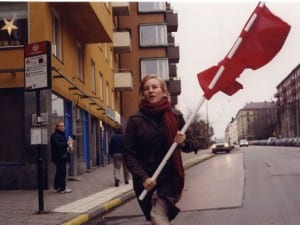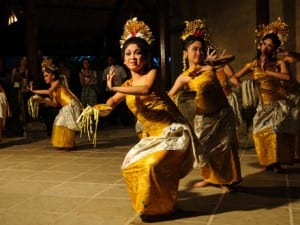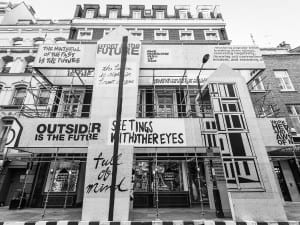The Aesthetica Art Prize 2014 opens its new ground-breaking exhibition this spring, showcasing the very best of emerging talent in contemporary art internationally. Managed by Aesthetica Magazine in partnership with York Museums Trust, the exhibition will take place from 4 April to 22 June at York St Mary’s – York Art Gallery’s contemporary art space.
Included in the Top 100 Artists Longlist for the Art Prize is Clara Aparicio Yoldi, a video artist who uses found footage and plays with editing to extrapolate new meaning. Her work Laisse Tomber Les Filles (Leave the Girls Alone) cuts and loops short segments of footage from both dance scenes of Vivre sa vie and Buffalo ’66. The result is a play of seduction and frivolous dance where individual dramas are hidden behind loops and repetitions. We speak to Aparicio Yoldi about her practice.
A: What was the inspiration for your film Laisse Tomber Les Filles (Leave the girls alone)?
CAY: My main inspiration is Eisenstein and his theory of intellectual montage as an alternative system to continuity editing. New ideas emerge from the collision of the images, ideas that were not innate in any them. A new concept explodes into being. That’s why I used footage from two films. Copying, pasting, looping and confronting these images, I created a totally different story.
Godard is another important inspiration, and the video is also a homage to him and his films, which I find visually fascinating. I used footage of his film Vivre sa vie, because in that scene, he breaks the logic and continuity rules of narrative cinema. It’s as if the film stops and the character, interpreted by Anna Karina, starts dancing for more than 2 minutes with almost no logic within the story. I found that amazing and since I watched the film years ago I had in mind to do something with that.
Vincent Gallo in his movie Buffalo ’66 does something similar. That’s the other film that I’ve used for this video. Christina Ricci is in the bowling alley playing and suddenly the lights go down, and a spot light appears over her and she starts dancing as well, without any narrative logic for the story, it’s like a parenthesis in the film.
A: How do you hope viewers will respond to your film?
CAY: I hope viewers smile and enjoy watching the film. It’s meant to be fun, watching it and hearing the music. That’s the first level, the most instinctive. Two women dancing. But they’re not trying to seduce, they’re pretending to seduce, but it’s almost as if they’re making fun of the dancing seduction.
Art in my opinion always has different levels. In my pieces I always want to do, first of all, something that people enjoy visually, something beautiful to see and enjoyable to watch. After that, people can go deeper if they want. They can recognise the films or characters and start making associations. That’s a more cerebral pleasure.
Another thing that I hope the viewer will notice is that instead of a woman dancing for a man like in both original films, each woman here dances for the other one. They are “seducing” each other, breaking with the stereotypes of cinema.
If this film is watched years later, I would like people to see it as a reflection of our time, where, in the different mediums of expression (literature, cinema, visual arts) we are attending to the fragmentation of the narrative discourse. We are questioning the traditional narrative resources with the juxtaposition of images, texts, copy-paste collages of a schizophrenic nature.
A: What inspired you to make artists’ films?
CAY: I guess that you just need a tool to express yourself creatively, it doesn’t matter what medium you use. Art is a way to express and transmit new aspects of reality. The artist discovers and perfects new languages that more directly correspond with our experiences. I always liked to experiment with different formats and new technologies.
Cinema is one of my main inspirations. Directors that I find visually inspirational are: Jean-Luc Godard, David Lynch, Stanley Kubrick, Wong Kar-Wai, Julio Medem, Larry Clark and Miranda July. The audiovisual language has a lot of possibilities but cinema is a big industry, it needs a lot of people, a large budget and is a long process, so the creative concept is diluted along the way. The video is cheaper, faster and gives you total independence and control of the final result.
The moment I decided to do video art was when I saw an exhibition of the Swiss video artist Pipilotti Rist in my home city, Madrid, in the Reina Sofia Museum. I was fascinated by her visually striking work, intelligent criticism and sense of humour. I decided then that I wanted to make videos.
I started working with moving image, recording and editing my own videos and learning how to use different software for design, animation, video editing and after effects. With video art I feel free from the limitations of the cinema industry and the narrative and logical rules. It’s like writing poems instead of novels if we compare to literature. Video art can be closer to the world of dreams and thoughts.
A: Are there any other artists you would like to collaborate with?
CAY: An entry in a blog is like a message in a bottle thrown into the sea… you never know who is going to read it so… I would love to collaborate with artists like: Pipilotti Rist, Tracey Emin, Marina Abramovic, Bill Viola, Bruce Nauman, or directors like Michel Gondry, Jonathan Glazer, musicians like Philip Glass, Patti Smith, PJ Harvey and Thom York!
I would love to collaborate with people from other disciplines: actors and actresses, dancers, painters, writers, architects, programmers, sound artists, engineers, light and visual designers, etc. and mix all different formats to create a collaborative piece of art.
I love working with musicians. If I like the music, it inspires me. Normally, when I work on a video, the first thing I do is choose the music, or ask the musician to create it before I start working on the visuals, or sometimes even before I’ve conceived the idea. Then I hear the piece again and again for hours, and then days, and the images start appearing in my head.
For the soundtrack of Leave the girls alone, I worked with the musician Ciara Clifford. We have collaborated in several videos and we understand each other very well. I told her the idea: copy and paste, loops, repetitions, sense of humour, and a re-interpretation of the old song Laisse Tomber Les Filles by Serge Gainsbourg and she came out with this fantastic track. From there I could start building the video.
A: Are there any spaces you would like to see your work exhibited?
CAY: I love old buildings. When you walk into an old church, or palace, or museum, it’s as if you can feel everything that’s happened there before, and it’s a very special feeling. I guess I would like to see my pieces in a space that had lots of experiences inside. I’m honoured and happy to show my work in York St Mary’s as is a beautiful place and is full of history.
New formats need new spaces. For film and video, I prefer spaces similar to cinema: dark, with big screens, comfortable chairs and surround sound. This can also be designed in an exhibition space, with an installation, as an extension of the piece of art, a space in which the spectator is comfortable and ready for what they are going to see. Or recycling old buildings that had other uses before and transform them into something totally different.
I would like my videos to reach other countries, continents and cultures, the same as I like to know artists from all over the world. So that we can share our experiences and creations with as many people as possible.
Finally, continuing with the theory of the message in a bottle: MOMA (New York), Tate Modern (London) or Museo Reina Sofia (Madrid).
Aparicio Yoldi’s film will be shown on a looped monitor within the gallery as part of the 100 longlisted artists. Eight shortlisted works comprise the exhibition.
Aesthetica Art Prize exhibition in partnership with York Museums Trust, 4 April – 22 June 2014, York St Mary’s, Castlegate, York, YO1 9RN. For more information visit www.aestheticamagazine.com/artprize and www.yorkstmarys.org.uk.
Credits
1. Clara Aparicio Yoldi, Laisse Tomber Les Filles (Leave the Girls Alone).





